|
|
||||
|
Published by : PROFESSIONAL MEDICAL PUBLICATIONS |
||||
|
ISSN 1681-715X |
||||
|
||||
|
- |
||||
|
ORIGINAL ARTICLE |
||||
|
- |
||||
|
Volume 24 |
April - June 2008 (Part-I) |
Number 2 |
||
|
|
||||
|
||||
|
|
||||
|
Published by : PROFESSIONAL MEDICAL PUBLICATIONS |
||||
|
ISSN 1681-715X |
||||
|
||||
|
- |
||||
|
ORIGINAL ARTICLE |
||||
|
- |
||||
|
Volume 24 |
April - June 2008 (Part-I) |
Number 2 |
||
|
|
||||
|
||||
Knowledge of diabetic patients about diabetes
at the primary stage in Eskisehir, Turkey
Didem Arslantas1, Aleattin Unsal2, Selma Metintas3, Filiz Koc4
ABSTRACT
Objective: To define the demographic characteristics of diabetes patients receiving care at the primary stage to establish the number of diabetics with complications.
Methodology: Patients who were referred to Eskisehir central village clinics in Turkey were included in the study. A survey was conducted via face-to-face interviews. Four hundred ninety five diabetic patients were referred to the polyclinic within the study period.
Results: Majority of the patients had a positive family history, hypertension and obesity. Only 14.5% of the patients were able to check their plasma glucose levels by themselves. None of the patients had HbA1c level results in their follow-up files. In addition, they were unaware of what HbA1c signifies or what it entails. 21.9% of the diabetics developed a complication. Increases in age, positive family history, long duration of diabetes were responsible for the presence of complications.
Conclusions: Though the diabetics were attentive to their own controls but very few were able to check their blood sugar levels by themselves at home. Education of diabetics is extremely important to achieve desired blood glucose levels thus ensuring good control and prevent complications.
KEY WORDS: Type-2 Diabetes, Knowledge, Education.
Pak J Med Sci April - June 2008 (Part-I) Vol. 24 No. 2 263-268
1. Didem Arslantas,
2. Aleattin Unsal,
3. Selma Metintas,
4. Filiz Koc,
1-4: Medical Faculty,
Department of Public Health,
Eskisehir-Osmangazi University,
Meselik,
Eskisehir,
Turkey 26480.
Correspondence
Didem Arslantas,
Medical Faculty,
Department of Public Health Meselik,
Eskisehir-Osmangazi University,
Meselik,
Eskisehir,
Turkey.
Email: adidem@ogu.edu.tr
darslantas@yahoo.com
* Received for Publication: November 3, 2007
* Revision Accepted: January 25, 2008
INTRODUCTION
Diabetes Mellitus is a very complex disease. It has emerged as one of the world’s biggest health problems and its prevalence is increasing at an alarming rate. Over 110 million people are reported to be suffering from diabetes and this is almost certainly an underestimate.
1 People with diabetes who wish to live normal lives will need to know a lot about their illness.2 The National Standards for Diabetes Self- Management Education has defined patient education as "an exchange of knowledge, tools and practices that will address the client’s needs".3Patients with diabetes mellitus often lack sufficient knowledge about their disease and thus frequently have poor self-management skills.
4 Knowledge in relatives of diabetics is also important because of their increased risk of getting the disease; appropiate knowledge is also essential to notice the diabetes symptoms when they appear and to help avoide risky lifestyles.5Diabetics must understand that their own treatments bear utmost importance for the sake of controlling the disease. During their education, short term and long term objectives should be identified. These must include compliance with drug therapy, nutrition plans, change in life style, regular ophthalmic examination, and meeting emergencies. All this is aimed at increasing the diabetics’ quality of life through these multidisciplinary approaches.
6This study was conducted to find out the demographic characteristics of diabetes patients receiving care at primary stage to establish the number of patients with complications.
METHODOLOGY
Patients who were referred to Eskisehir Central Village Clinics (No. 2, 5 and 11) were included in this study. The data was collected through a survey based on face-to-face interviews. The survey included questions like socio demographic characteristics, duration of diabetes, type of treatments, family history, sources of information the patient obtains regarding the diabetes, the most recent level of fasting plasma glucose, arterial blood pressure, cholesterol-lipid values, height-weight measures, results of the urine tests, presence of a complication, and if so, time period of the complication, whether the patient was aware of the hypoglycemic reactions and in case of such reaction, measures to be taken, whether the patient checks his/her own plasma glucose, intervals between the glucose checks, smoking history, whether the family members show their support, and finally, if they attach importance to his/her education about of the disease.
Ethical approval: Procedures in this study were in accordance with the Helsinki Declaration of 2000. The study protocol was approved by the local Ethics Board. Before starting the main survey, a pilot study was performed.
The data obtained were analyzed with SPSS software package. Among the statistical tests, X², t, and Spearman’s correlation tests were utilized.
RESULTS
Four hundred ninety five diabetic patients were referred to the polyclinic within that period. Three hundred eighty two of them (77.2%) were female and 113 (22.8%) males. The distribution of diabetes patients in accordance with their socio demographic characteristics is given in Table-I: Average age of the study group was 58.84 ± 10.02.
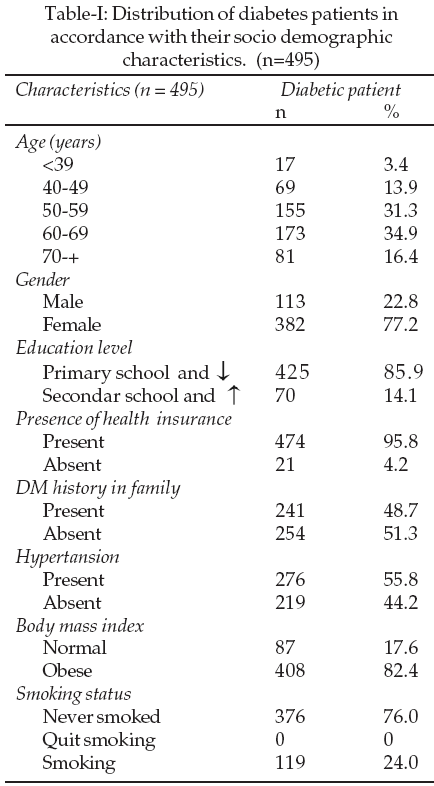
The analysis of the education levels of the study group indicated that 425 individuals (85.9%) were graduate of primary school or below and the education level of 70 individuals (14.1%) were secondary school or above. Twenty one patients (4.2%) did not have social security. Various characteristics of the diabetics who were referred to diabetes polyclinic are given in Table-II.
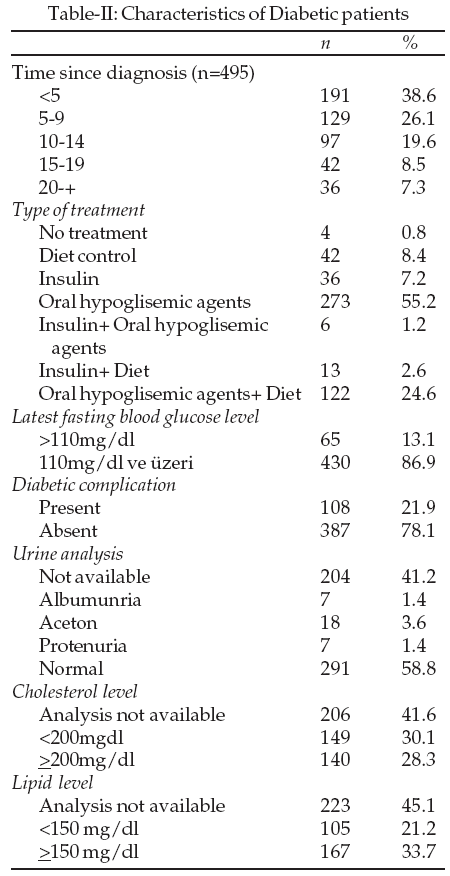
HbA
1C level was also studied as a control criterion. However, none of the patients had HbA1C level results in their follow-up files. In addition, they were unaware of what HbA1C signifies or what it entails. Number of the patients who did not have the results of urine, cholesterol, and lipid analyses were 41.2%, 41.6% and 45.1%, respectively, and this was found to be quite high.
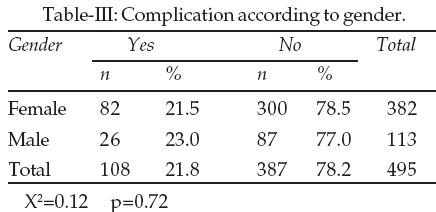
About 21.9% of the diabetics developed a complication. The distribution of the patients with complications based on their age and gender are given in Table-III and Table-IV.

While there was no difference between male and female patients in terms of the presence of complication, patients with complications were suffering from the disease since long. A significant positive correlation did exist between age and complication, length of the disease being especially more significant.
Patients were asked various questions such as whether they knew about diabetes, the authority from which they obtained the information, whether they were able to check plasma glucose by themselves. The answers to these questions are given in Table-V.
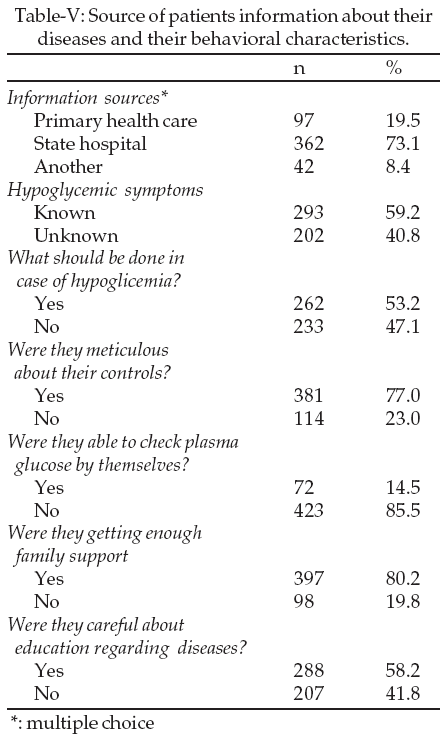
It was intriguing to find out that while diabetics obtained the information mostly from the State Hospitals, the second stage health care institutions, many of the patients knew hypoglycemic symptoms and how to act, they were meticulous about their controls, and that they were careful about their education concerning diabetes. However, only 14.5% of the patients were able to check their plasma glucose levels by themselves. The logistic model results that were obtained through age, duration of diabetes, diabetes history of the first-degree family members, presence of hypoglycemic reactions which may lead to all complication are given in Table-VI.
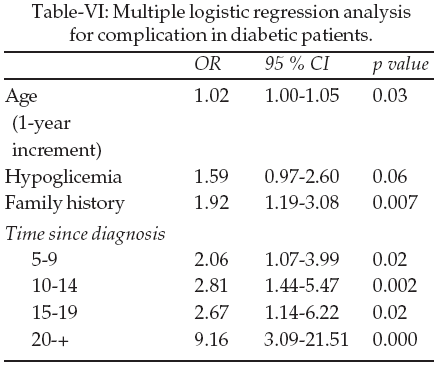
Increase in age, positive family history prolonged duration of diabetes were some of the factors which resulted in complications.
DISCUSSION
Diabetes as a disease has a negative effect on the patient’s quality of life due to its possible complications. Primary stage of the disease is an important in terms of education and training of the patient since it is the primary consultation authority for many diseases in Turkey. In our study, it was observed that most of the patients were female (77.2%) and 60-69 in year’s age group. Most of the diabetics (38.6%) stated that they were diagnosed less than five years ago. Similarly, a study carried out in China
7 reported that female patients constituted the majority and 67.3% were diagnosed less than five years ago while another study conducted in England showed that males were more in number, the average age was 58 years and their average duration of disease was 8.6 years.8In this study, patients with a positive family history, hypertension, and obesity were more in number. Smokers constituted 24%. The fact that these chronically ill patients smoke and are overweight was significant. In addition, four patients reported that they never had a treatment. When a value of 110mg/dl was assigned as plasma glucose regulation, 86.9% had a level higher than this criterion and the average glucose level was 169.12±67.11. Another significant fact was that around 42% of the patients were not tested for cholesterol and lipid levels. As is widely known, patient education constitutes a cornerstone in the management of diabetes, knowledge of diabetes forms the basis for informed decisions about diet, exercise, weight control, blood glucose monitoring, use of medications, foot and eye care and control of macrovascular risk factors.
9 The instructions given to diabetic patients must always contain the importance of follow up and the steps to be followed during each follow up visit should be stated in a detailed manner. According to the current medical knowledge, sugar control is only one part of medical care. Body weight maintenance, blood pressure control, hypercholesterolaemia treatment and smoking cessation are also equally important in diabetes management.10The direct methods include the inspection of the feet and blood analysis of glycosylated hemoglobin level (HbAI
C) which is the most direct and stable retrospective index of glucose control over time in diabetic patients.11 The HbAIC value was collected from the patients records and it was the last blood glucose assessment available within the past two months. The patient’s compliance level could be supported by the optimal mean HbAIC of less than 7%.12 None of the patients were aware what HbAIC implies and what the lower-upper limit is and none of them had such a test result. The fact that such an important result of a test, HbAIC, was unknown to the patients and it was never done before shows that this issue needs to be tackled seriously. These instructions should be given not only to patients but also to primary stage physicians assuming the same seriousness, the observation itself and criteria should be explained in a detailed manner. Although unaware of HbAIC, even then 52.8% of the patients stated that they were paying attention to the instructions concerning diabetes. This raises the question whether the education being imparted was adequate. Most of the patients knew hypoglycemia symptoms and what to do during hypoglycemia; they also stated that they were meticulous about their follow-up and they were receiving enough support from the family members concerning their disease (cooking meals suitable for their diets, reminding them to take their medicine, encouraging them to pay attention to their check-up).Another interesting point was the less number of patients who were able to check their own blood glucose levels. In a study conducted in Singapore, it was reported that 89.5% of diabetics were regularly going through check-ups, 64.2% of them previously joined an education program on diabetes, and 42.1% of the patients were aware of the importance of glucose monitoring but did not carry out the follow-ups by making the glucose measurements at home.
13 In a study conducted in USA, it was reported that 30% of the patients did have the information concerning the hypoglycemia symptoms, and 8% were aware of the normal levels of HbAIC.14 In a study carried out in Glasgow, it was reported that as the education level rises and diabetes period prolongs the diabetics knowledge of diabetes increases.8There was no difference between females and males in terms of the prevalence of complications. A single unit increase in age was raising the risk of complication prevalence 1.02 times and the possible positive results of family history 1.92 times. Risk of complication was increasing with the duration of the disease and the risk was rising nine times in patients diagnosed 20 years ago or more. In order to be able to prevent complications, check-ups must be carried out on a strictly regular basis and the blood glucose levels must be kept well under control.
13 Some studies have shown that appropriate knowledge of diabetes is effective for good diabetes control, while there are others indicating biomedical knowledge does not necessarily mean effective control; rather economic, cultural and particularly familial influences can facilitate or hinder procedures for diabetes control.15,16 In a study carried out in Ankara, it was reported that 77.2% of the diabetics had diabetes-related ocular complications.17 Much has been written internationally of the need to help diabetic persons maintain good control of DM in order to prevent and minimise complications.18,19CONCLUSION
Apart from the fact that diabetics were attentive to their own controls, patients able to check their blood sugar levels by themselves at home for glucose checks were less in number. The absence of HbAIc in their follow-up files – a very important criterion since it shows the blood glucose level of the last three months of diabetes patients – and the fact that the patients were unaware of what HbAIc implies was quite an intriguing fact. Hence we conclude that all diabetics must be provided good education programme about the disease. Not only that but the importance of finding out HbAI
C levels at regular interval should also be taken up seriously.REFERENCES
1. World Health Organization, Prevention of diabetes mellitus, WHO Technical Report Series No:844.Geneva: WHO;1994.
2. Stam DM, Graham JP. Important aspects of self management education in patients with diabetes. Pharmacy Practice Management Quarterly 1997;17:12-25.
3. Mensing C, Boucher J, Cypress M, Weinger K, Mulcahy K, Barta P, et al. National standards for diabetes self-management education. Task Force to Review and Revise the National Standards for Diabetes Self Management Education Programs. Diabetes Care 2000;23:682-9.
4. Via P, Salyer J. Psychosocial self-efficacy and personal characteristics of veterans attending a diabetes education program. Diabetes Educ 1999;25:727-37.
5. van der Sande MA, Walraven GE, Milligan PJ, Banya WA, Ceesay SM, Nyan OA, et al. Family history: an oppurtunity for early interventions and improved control of hypertension, obesity and diabetes. Bull World Health Organ 2001;79:321-8.
6. West JD, Goldberg KL. Diabetes self-care knowledge among outpatients at a Veterans Affairs Medical Center. Am J Health-Syst Pharm 2002;59:849-52.
7. Chan YM, Molassiotis A. The relationship between diabetes knowledge and compliance among Chinese with non-insülin dependent diabetes mellitus in Hong Kong. J Advanced Nursing 1999;30:431-8.
8. Baradaran H, Knill-Jones R. Assesing the knowledge, attitudes and understanding of type 2 diabetes amongst ethnic groups in Glasgow, Scotland. Practical Diabetes Int 2004;21(4):143-8.
9. Murata GH, Shaha JH, Adam KD, Wendel CS, Bokhari SU, Solvas PA, et al. Factors affecting diabetes knowledge in Type 2 diabetic veterans. Diabetologia 2003;46:1170-8.
10. American Diabetes Association. Standards of medical care for patients with diabetes mellitus. Diabetes Care 2003;26:33S-50S.
11. Brown SA. Meta analysis of diabetes patient education research: variations in intervention effects across studies. Research in Nursing & Health 1992;15:409-19.
12. Chan JCN, Yeung VTF, Chow CC, Cockram CS. Diabetes mellitus-epidemiology and pathogenesis. Hong Kong Practitioner 1996;18:270-9.
13. Tham KY, Ong JJY, Tan DKL, How KY. How much do diabetic patients know about Diabetes mellitus and its Complications? Ann Acad Med Singapore 2004;33:503-9.
14. Rothman RL, Malone R, Bryant B, Wolfe C, Padgett P, DeWalt DA, et al. The spoken knowledge in low literacy in diabetes scale. The Diabetes Educator 2005;31:215-24.
15. Develepment programme for the prevention and care of diabetes in Finland 2000-2010, Appendix 2, St. Vincent Programme a diabetes programme in action. http://www.diabetes.fi/english/programme/programme/appendix2.htm (accessed 8 September 2003.
16. Norris SL, Nichols PJ, Caspersen CJ, Glasgow RE, Engelgau MM, Jack L, et al. Increasing diabetes self-management education in community settings. A systematic review. Am J Prev Med 2002;22(suppl 4):S39-S66.
17. Caliskan D, Ozdemir O, Ocaktan E, Idil A. Evaluation of awareness of diabetes mellitus and associated factors in four health center areas. Patient Education and Counseling 2006;62:142-7.
18. The Diabetes Control and Complications Trial Research Group. The effect of intensive treatment of diabetes on the develepment and progression of long-term complications in insülin dependent diabetes mellitus. N Engl J Med 1993;329:977-86.
19. UK Prospective Diabetes Study (UKPDS) Group. Intensive blood glucose control with sulphonylureas or insülin compared with conventional treatment and risk of complication in patients with type 2 diabetes. Lancet 1998;352:837-53.
HOME | SEARCH | CURRENT ISSUE | PAST ISSUES
Professional
Medical Publications
Room No. 522, 5th Floor, Panorama Centre
Building No. 2, P.O. Box 8766, Saddar, Karachi - Pakistan.
Phones : 5688791, 5689285 Fax : 5689860
pjms@pjms.com.pk